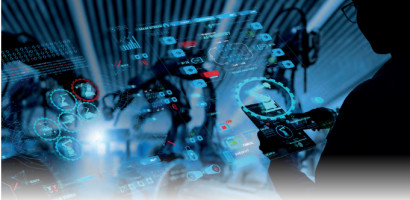According to a poll conducted amongst the audience during the event, which asked, “do the green shoots emerging on the foliage outside the studio match those of IIoT in UK manufacturing?”, the answer is: yes and no. Only 10% judge themselves to be at an advanced level, while the remaining 90% were approximately equally divided amongst “Not sure where to start”, “At the start”, and “Midway on the journey”.
On the panel on this occasion were:
Jean-Paul Verheylewegen, Global Sales Manager, MB Connect Line (the IT security company acquired by Red Lion Controls in 2022)
Chris Barlow, Sales & Marketing Director, Novotek
Alejandra Matamoros, Technology Manager, Manufacturing Technology Centre
Luke Walsh, Managing Director, Brainboxes
Digitalisation is a journey, so to start with, keep it simple, start small, then scale up. We look at the how to get people and technology on the right road. Leading off, Jean-Paul highlighted the maxim of starting with small pilot projects, whilst having an holistic vision in mind of the overall benefits of digitalising the whole enterprise. Not so much “start small”, but “start smart” as he put it, a concept which all the panelists agreed.
Jean-Paul explained that there are two parts to an IIoT project: the first part is collecting data in the field from a variety of IoT devices, scale it, process it and then push it to a higher system, as an MES. The second part is generating value out of that data and distributing it. Two different sets of skills are required: people with an IT knowledge may have difficulties with data acquisition from the field, people with a more OT profile may have difficulties with cloud systems, value creation or distribution, because the tools that are used there require more specific IT competencies.
The theme continued with Chris, who focused on how to manage the data flow issues, all the way from acquisition to usage and thence to storage. Like Jean-Paul, he acknowledged the importance of getting people on board the journey, citing potential conflicts for budgets and even personnel themselves. He explained the differences by comparing a SCADA system, used for real-time visualisation and the control of a manufacturing system, with an MES, which is about bridging business systems and control systems, and managing people and processes and all of the data involved in transforming raw materials into finished goods.
Luke interjected that before you can choose between a holistic approach or a piecemeal approach to digitlisation, you need to convert the workforce from being (possibly) Digital Sceptics towards being Digital Champions - in his view, you cannot do this overnight, but in a slow measured approach.
Alejandra spoke at our Talking Industry Live programme in 2022 at the Drives and Controls Exhibition in 2022. She remains not only the first person hailing from Venezuela to take part, but also the first from the continent of South America. With the exception of Antarctica, we now have featured at least one person from every continent. Here, she discussed the differences between the traditional hierarchical ways of integrating production systems and the IIoT methods. What are the potential and challenges of networked production systems?
She said that at the MTC, the emphasis is to take the that holistic view, to discover and understand that long term vision. That doesn’t come with only bringing the seniors to that meeting, but involving all key stakeholders from those processes. Then, and only then, you can start delivering the project in smaller chunks. So start small, but to plan for that with a proper technology roadmap that takes you through the whole transformation journey.
Unusually, we concluded the formal part of the discussion with a demonstration, in this case of the Brainbox smart energy monitoring system, which utilises IIoT connectivity to efficiently capture, aggregate and analyse plant-wide energy data. This is a great example of a small step which delivers an immediate return to the bottom line. Luke cited an example where one company discovered that they had been operating on their backup compressed air system for months without even knowing! With current energy prices, it is no surprise that the machine elicited great interest from several attendees in the chat.
We could not let our panelists go without asking them about the future of AI in manufacturing, as part of the digitalisation process. Luke jumped in to say that in his view digitalisation must come first. “AI has gone from being peddled as snake oil to actually having a legitimate place within the environment of manufacturing. And its legitimacy is only just starting to kind of show itself to us. AI depends on digital data and can manipulate digital things exceptionally well.”
Chris added that predictive maintenance is an area which benefit greatly from elements of machine learning. There may be other areas to find that will probably be going to be where the greatest proliferation will occur, at least in the beginning.
Alejandra expressed reservations about the safety and ethical aspects associated with using artificial intelligence algorithms. “We need still to evolve warranty policies that will actually define the concerns and the boundaries of how far AI can actually be taken,” she suggested.
Jean-Paul concluded that AI works on data and (as a comment in the chat pointed out) regardless of the potential capabilities of AI in the future, companies need to digitally transform first. As was shown in the poll, we are still in the process of digitising industry. The methodology is still being built. He sees AI as a new tool that will evolve to be helpful in interpreting data.
There are many ways to catch up if you missed it: Talking Industry episodes are available on demand, and as Podcasts at: https://talkingindustry.org/
https://twitter.com/TalkingIndustry
https://www.linkedin.com/company/talking-industry/

